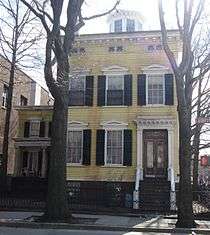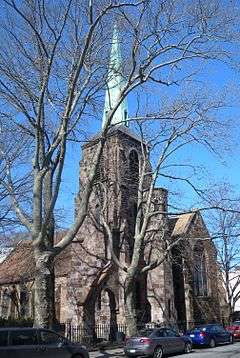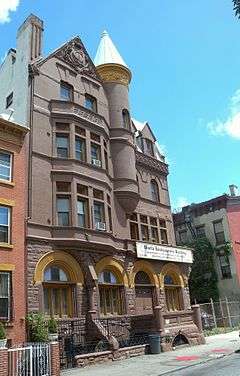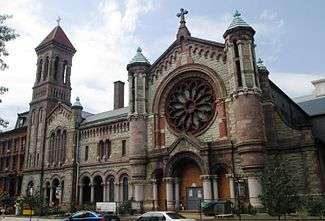Clinton Hill, Brooklyn
Coordinates: 40°41′23″N 73°57′55″W / 40.68972°N 73.96528°W
Clinton Hill is a neighborhood in north-central Brooklyn, a borough of New York City. It is bordered by the Brooklyn Navy Yard and the Brooklyn-Queens Expressway to the north, Williamsburg to the northeast, Classon Avenue and Bedford–Stuyvesant to the east, Atlantic Avenue and Prospect Heights to the south and southwest and Vanderbilt Avenue and Fort Greene to the west.[1][2]
The neighborhood is served by the NYPD's 88th Precinct.[3] "The Hill", as the general area was known – with a maximum elevation of 95 feet (29 m), the highest in the area[1] – was believed to have health benefits because many people believed that germs were more prevalent in low-lying areas. The area is named after Clinton Avenue, which in turn was named in honor of New York Governor DeWitt Clinton (1769–1828).[4] The main thoroughfare is DeKalb Avenue.[1]
The affluent[1] neighborhood's mixture of apartment buildings, mansions, brownstone and brick rowhouses, and the Pratt Institute and St. Joseph's College, built at various times in a number of different styles, is a great part of its charm.[5]
History

The area’s European history began in the 1640s, when Dutch settlers laid tobacco plantations near Wallabout Bay. Bedford Corners, situated just southeast of Clinton Hill, was incorporated in 1663, and the settlers (both Dutch and French Huguenot) purchased surrounding lands from the native Lenape in 1670.[4]
On August 27, 1776, the "Road to Jamaica" (approximately Atlantic Avenue, the southern edge of today’s neighborhood) was used by the British army in a surprise overnight march to outflank the American army, which was forced to retreat toward Gowanus Creek, and two nights later, to Manhattan. After the war, the Dutch continued to build on the land, which sloped toward the East River and offered great views of the water and of Manhattan.[4]
The tree-lined Clinton Avenue was laid out as a boulevard along the crest of the hill in 1832,[1] and by the 1840s, Clinton Hill and neighboring Fort Greene had become fashionable neighborhoods for the wealthy of Brooklyn, who could commute to Manhattan by way of stagecoach to the Fulton Ferry. The area was originally devised as a rural get-away for those "determined to escape from the closeness of city life", as Walt Whitman, editor of the Brooklyn Daily Eagle, put it in 1846. George Washington Pine had bought up the land in the area and broke it into lots, selling them to those who wanted to lead a quiet life not too far from the conveniences of the Navy Yard.[4] Whitman, a 28-year resident of Brooklyn, had lived for less than a year in the area in 1855, where he completed his masterpiece Leaves of Grass. The 1995 New Yorker article "Walt Whitman’s Ghost”[6] identified the address as 99 Ryerson Street, which still stands.[4]
In the 1860s, after the Civil War, Clinton Hill was developed with row houses,[7] which dominated the street scene by the 1880s.[1] These attracted affluent professionals.[1]
The area's development continued after Charles Pratt, an oil executive, built a mansion at 232 Clinton Avenue, which is now part of the Brooklyn campus of St. Joseph's College's. Pratt also built houses there for his sons, which he gave to them as wedding gifts; other mansions followed,[1] part of the general migration of merchants from New York City (Manhattan) to Brooklyn,[8] and the area became known as Brooklyn's "Gold Coast".[5] Pratt founded the Pratt Institute in 1887, and its campus remains a focus of the neighborhood.[1]
After the late 1870s, Clinton Hill was one of the stops on the Brooklyn, Flatbush and Coney Island Railway (BF&CI, now part of the Brighton subway line), an excursion line which would bring families from the neighborhood to Brighton Beach for a day of recreation, and allow them to be home "at a reasonable hour". Entire families would use the BF&CI to relocate to the newly built Brighton Beach Hotel – owned by the same men who built the railroad – for the summer months, while the paterfamilias commuted to New York via ferry to work.[9]
By 1900, apartment buildings were being built on Clinton Avenue, which replaced the mansions there and on Washington Avenue by the 1920s and 40s. In addition some of the remaining mansions were converted into rooming houses in the following decades, and urban renewal, part of Robert Moses' relentless rebuilding of the city, cleared five blocks south of the Pratt Institute, destroying the brownstones there. This was followed in the 1970s by the brownstone revival, in which many of the remaining brownstones were restored.[1] In the 2000s, the neighborhood became somewhat gentrified, with generally wealthier people moving into the area.[10]
Demography
Clinton Hill's population is racially mixed, with 55% of the residents white or Asian and 45% African American. Ethnic groups represented include people of Italian descent and immigrants from the Caribbean. The residents include many "artists, architects, photographers, and craftspeople". In the 21st century, the neighborhood has experienced a significant increase in population, with increased gentrification and a growing upper-middle-class population.[1]
Landmarks

The Clinton Hill Historic District was listed on the National Register of Historic Places in 1985. The district includes the mansions of Clinton Avenue, built in the 1870s and 1880s. The most prominent of these are linked to Charles Pratt, who built a mansion for himself at 232 Clinton Avenue in 1874, the year his Charles Pratt & Company was acquired by Standard Oil,[4] and one each as wedding presents for three of his four sons. These four mansions can be seen on Clinton Avenue between DeKalb and Willoughby. The rest of the historic district is noted for its prominent Italianate and Beaux-Arts rowhouses.[11] The Clinton Hill South Historic District was listed in 1986.[11]
St. Mary's Episcopal Church at 220 Classon Avenue in Clinton Hill, built c.1859, and the Mechanics Temple, which was built at 67 Putnam Avenue as the Lincoln Club in 1889, are both part of the historic district.[1][12]
Other buildings in the Historic District include a Gothic Revival wooden house at 284 Clinton Avenue, built c.1854; an Italianate brick and stone villa dating from c.1850 at 447 Clinton Avenue, intact runs of mid-19th century rowhouses on Grand Avenue, St. James Place and Cambridge Place as well as on DeKalb Avenue and Waverly Avenue; mansions frop the "Gold Coast" era in the 200 to 400 blocks of Clinton Avenue;[note 1] and at 367 Washington Avenue; and apartment houses on Clinton Avenue.[5][12]
On Lafayette Avenue can be found both the Emmanuel Baptist Church, completed in 1887, and the Joseph Steele or Steele-Skinner House of 1812, while Clinton Avenue offers the Church of St. Luke and St. Matthew (1891) and the Royal Castle Apartments, completed in 1912. All are individually landmarked.[1][5][12]
Many of the buildings of the Pratt Institute are landmarked, or of architectural interest, and St. Joseph's College utilizes several of the former Pratt family mansions on Clinton Avenue.[12]
The brick building at 275 Park Avenue was built in the 1890s as a chocolate factory that produced and distributed Tootsie Rolls throughout the United States. In 2002, the building was converted into loft apartments.[13]
Gallery
 200 Lafayette Avenue, Joseph Steel or Steele-Skinner House
200 Lafayette Avenue, Joseph Steel or Steele-Skinner House
(1812) 447 Clinton Avenue, originally the David Burdette House, later the Galilee Baptist Church
447 Clinton Avenue, originally the David Burdette House, later the Galilee Baptist Church
(c.1850) William W. Crane House, 284 Clinton Avenue
William W. Crane House, 284 Clinton Avenue
(Field & Correja, c.1854) St. Mary's Episcopal Church
St. Mary's Episcopal Church
(Richard T. Auchmuty, c.1859) Emmanuel Baptist Church
Emmanuel Baptist Church
(1887) Mechanics Temple, originally the Lincoln Club, at 67 Putnam Avenue
Mechanics Temple, originally the Lincoln Club, at 67 Putnam Avenue
(Rudolph L. Daus, 1889) Church of St. Luke and St. Matthew
Church of St. Luke and St. Matthew
(John Welch, 1891) Royal Castle Apartments, 20 Gates Avenue
Royal Castle Apartments, 20 Gates Avenue
(Wortmann & Braun, 1912)
Education
Pratt Institute, founded by Charles Pratt in 1887, is located in Clinton Hill. Pratt began as an engineering school, designed to train immigrants in then-novel sciences.[4] Today the school is known for having some of the highest ranking programs in architecture, graphic design, interior design, and industrial design.
The Brooklyn campus of St. Joseph's College is in Clinton Hill.[14]
Transportation
Clinton Hill is served by the IND Fulton Street Line (A C trains), with a stop at the Clinton–Washington Avenues Fulton Street Line station, as well as the IND Crosstown Line (G train), with stops at Classon Avenue and Clinton–Washington Avenues Crosstown Line stations. Several New York City Transit local bus routes provide service to the neighborhood, including the B25, B26, B38, B45, B48, B52, B54, B57, B62, B69. Starting in the 1880s, the Myrtle Avenue and Lexington Avenue elevated lines served the area. The Lexington Avenue line followed Grand Avenue south from Myrtle. The last train on the Lexington Avenue line ran on October 13, 1950; dismantling of the elevated tracks began on November 1.[4]
Notable residents
Residents over the years have included:
- Asa Akira (born 1986), pornographic actress and adult film director.[15]
- Ted Allen (born 1965), writer and television personality.[16]
- Lester Bowie (1941-1999), avant-garde jazz (trumpet) musician owned Victorian-style home at 207 Washington Avenue for 20 years until his death in 1999.
- Adrian Grenier (born 1976), actor.[17]
- Heems (stage name of Himanshu Suri), rapper.[18]
- Tehching Hsieh (born 1950), performance artist.[19]
- Talib Kweli (born 1975), rapper.[20]
- Mos Def (born 1973), rapper/actor.[21]
- The Notorious B.I.G. (1972-1997), rapper, grew up on 226 St. James Place, near the Bedford–Stuyvesant border;[21] the address was then regarded as part of Bedford–Stuyvesant.[22]
- David Paterson (born 1954), former New York Governor.[23]
- Danny Simmons, artist.[24]
- Rosie Perez (born 1964), actress.[21]
- Susan Sarandon (born 1946), actress, lives in a home described as "aesthetically ironic."[25]
- Patti Smith and Robert Mapplethorpe shared an apartment on Hall Street in 1967, after they first met.[26]
- John Thomas Underwood (1857-1937), entrepreneur and inventor who founded the Underwood Typewriter Company.[27]
- Walt Whitman (1819-1892), poet and editor of the Brooklyn Daily Eagle from 1846 to 1848, formerly lived at 99 Ryerson Street while working on Leaves of Grass.[28]
- Jeffrey Wright (born 1965), actor.[20]
- Malik Yoba (born 1967), actor.[20]
References
Explanatory notes
- ↑ At 229, 232, 241, 245, 278, 284, 300, 315, 321, 356, 380, 384, 404 & 406, 405, 410, 415, 443, 447, 457, 463 and 487 Clinton Avenue
Citations
- 1 2 3 4 5 6 7 8 9 10 11 12 13 Rawson, Elizabeth Reich. "Clinton Hill" in Jackson, Kenneth T., ed. (2010), The Encyclopedia of New York City (2nd ed.), New Haven: Yale University Press, ISBN 978-0-300-11465-2, p.272
- ↑ Jackson, Kenneth T.; Manbeck, John B., eds. (2004), The Neighborhoods of Brooklyn (2nd ed.), New Haven, Connecticut: Citizens for NYC and Yale University Press, ISBN 0-300-10310-7, p.xxxi
- ↑ 88th Precinct, New York City Police Department.
- 1 2 3 4 5 6 7 8 Williams, Keith. "Clinton Hill: suburban retreat". The Weekly Nabe. Retrieved 22 March 2012.
- 1 2 3 4 New York City Landmarks Preservation Commission; Dolkart, Andrew S. (text); Postal, Matthew A. (text) (2009), Postal, Matthew A., ed., Guide to New York City Landmarks (4th ed.), New York: John Wiley & Sons, ISBN 978-0-470-28963-1, pp.242-245
- ↑ Berman, Paul. "Walt Whitman's Ghost" The New Yorker (June 12, 1995)
- ↑ "Clinton Hill History Honored". The New York Times. United Press International. August 15, 1985. Retrieved 2009-08-22.
- ↑ Burrows, Edwin G. & Wallace, Mike (1999), Gotham: A History of New York City to 1898, New York: Oxford University Press, ISBN 0-195-11634-8, p.972
- ↑ Burrows, Edwin G. & Wallace, Mike (1999), Gotham: A History of New York City to 1898, New York: Oxford University Press, ISBN 0-195-11634-8, p.1135
- ↑ Besonen, Julie (December 2, 2015). "Clinton Hill, Brooklyn, a Neighborhood in Transition". The New York Times. Retrieved 2015-12-03.
- 1 2 National Park Service (2009-03-13). "National Register Information System". National Register of Historic Places. National Park Service.
- 1 2 3 4 White, Norval; Willensky, Elliot; Leadon, Fran (2010), AIA Guide to New York City (5th ed.), New York: Oxford University Press, ISBN 9780195383867 pp.644-652
- ↑ Maurer, Mark. "Clinton Hill chocolate factory-turned-rentals sells for $68M; HK Organization closes on 184K sf site, which was converted in 2002", The Real Deal (magazine), September 12, 2014. Accessed May 21, 2016. "The 123-unit, seven-story brick property at 255-275 Park Avenue was constructed as a Tootsie Roll factory in 1890s and later converted into lofts in 2002."
- ↑ Clinton Hill Campus, St. Joseph's College (New York). Accessed May 21, 2016. "St. Joseph’s Brooklyn Campus is in the heart of the historic Clinton Hill section of Brooklyn, one of the trendiest fusion neighborhoods outside of Manhattan."
- ↑ Cohen, Susannah. "From prep-school kid to millionaire porn star", New York Post, April 26, 2014. Accessed May 21, 2016. "Akira was 13 when her family moved back stateside to Downtown Brooklyn and later Clinton Hill."
- ↑ Staff. "Queer Eye's Ted Allen Buys Clinton Hill Brownstone", McBrooklyn, April 11, 2007. Accessed August 16, 2015.
- ↑ Schuster, Dana. "Wanna be in my gang?", New York Post, January 27, 2013. Accessed August 16, 2015. "Before you enter Entourage star Adrian Grenier’s Clinton Hill Victorian townhouse, toss your junk food to the curb."
- ↑ Tempey, Nathan. "Smoke this book", The Brooklyn Paper, November 11, 2013. Accessed May 21, 2016. "Clinton Hill rapper Heems of the defunct group Das Racist will also perform."
- ↑ Sontag, Deborah. "A Caged Man Breaks Out at Last ", The New York Times, February 25, 2009. Accessed August 16, 2015. "Afterward he sold his Williamsburg building, bought and renovated the loft in Clinton Hill, traveled with more frequency to China, married Ms. Li and eventually worked with the curators interested in shaping his legacy."
- 1 2 3 Franklin, Marcus via Associated Press. "Much change in Biggie Smalls' neighborhood", mlive.com, January 17, 2009. Accessed August 16, 2015. "Current residents include actor Jeffrey Wright and his wife, actress Carmen Ejogo; actor Malik Yoba; actress Rosie Perez; rapper-actor Mos Def; and rapper Talib Kweli."
- 1 2 3 Franklin, Marcus (January 18, 2009). "Much change in Biggie Smalls' neighborhood". The Times Herald. Associated Press. Archived from the original on March 5, 2012. Retrieved 2009-08-22.
- ↑ Morris, C. Zawadi, Biggie's 'One-Room Shack' in Bed-Stuy Now up for Sale, in Bed-Stuy Patch, April 3, 2013, 12:26 p.m., as accessed December 10, 2013.
- ↑ "Back in the U-S-S-Yards". Curbed.com. March 11, 2010. Retrieved 2010-03-16.
- ↑ Rush Arts Corridor Gallery
- ↑ Hogarty, Dave. "Third Home's a Hideous Charm for Susan Sarandon in Brooklyn", Curbed, January 31, 2012. Accessed August 16, 2015. "Try not to let the exterior fool you; Susan Sarandon's third and most recent real estate purchase in the last seven months does not mean she has lost her mind in a buying binge. The rather hideous front of 334 Grand Avenue in Clinton Hill conceals a considerably nicer interior."
- ↑ "Patti Smith Remembers Life With Mapplethorpe". Retrieved July 11, 2010.
- ↑ Underwood Park, New York City Department of Parks and Recreation. Accessed May 21, 2016. "This park, located in the Clinton Hill Historic District, was the site of the mansion of typewriter manufacturer John Thomas Underwood (1857-1937)."
- ↑ Rubinstein, Dana (March 10, 2007). "Putting Walt in a time vault". The Brooklyn Paper. Retrieved 2009-08-22.
External links
-
 Media related to Clinton Hill, Brooklyn at Wikimedia Commons
Media related to Clinton Hill, Brooklyn at Wikimedia Commons
